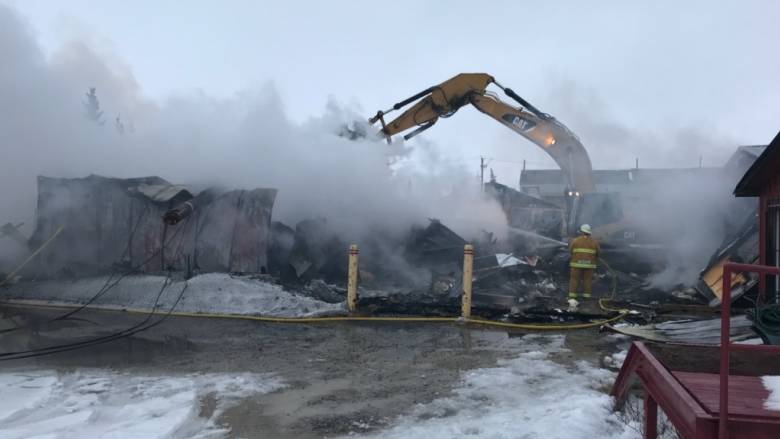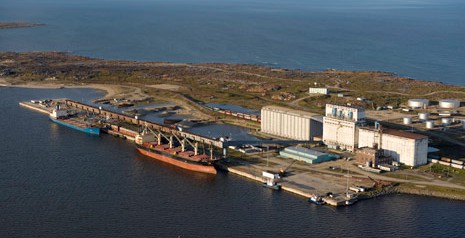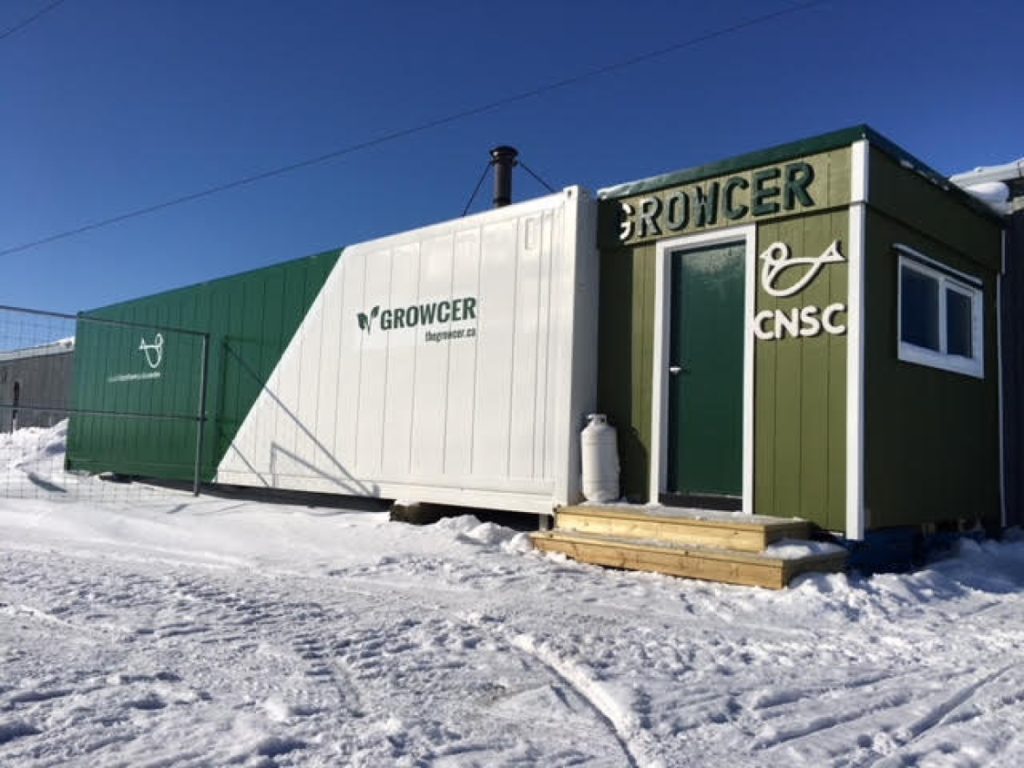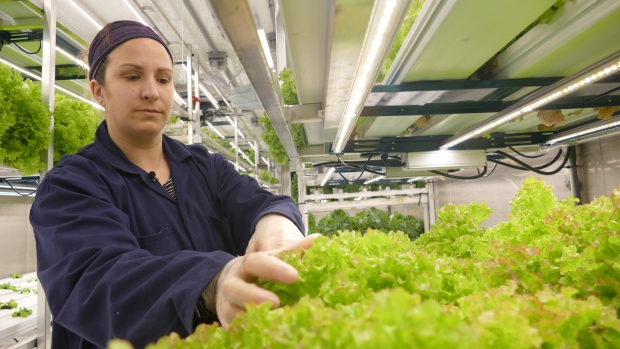by Steve Selden | May 13, 2018 | Churchill News

Churchill’s Gypsy Bakery burned to the ground in the early morning Sunday. Leroy Whitmore photo.
The iconic Churchill deli and restaurant that was the most popular gathering place in Churchill was destroyed in an early morning fire early this morning..
The building, described as a total loss by Churchill mayor Mike Spence, caught fire just after midnight. Fire crews were still putting out smoldering areas at 8 am this morning, according to Churchill Fire Chief Leroy Whitmore.
“There was heavy smoke and visible flames, coming through the rear of the roof,” said Whitmore.
Crews worked tirelessly from within the building to get a handle on the blaze but were driven back each attempt. Eventually Chief Whitmore made the decision to knock the structure down in order to protect adjacent staff housing and surrounding neighborhood homes.
No information concerning the cause of the fire has been offered. With the total loss and destruction of the building there’s a good chance we will never know.
“Due to the extent of the damage and the fire suppression efforts, the cause of the blaze is pretty much impossible to determine, now,” said Whitmore.
Luckily the blaze happened at a time when no patrons or employees were inside. Eleven volunteers fought the fire through the night, said Whitmore. No injuries from the fire crew were sustained either.
“There was heavy smoke and visible flames, coming through the rear of the roof,” said Whitmore.
Crews tried about half a dozen times to put out the flames inside, but eventually were forced into a defensive position and the decision was made to knock the building down in order to protect staff housing nearby, he said.
“A dozen volunteers battled the relentless fire the during the night”, said Whitmore.
Gypsy’s Bakery has been the social center of Churchill for 25 years and the DaSilva family has been like family to all who knew them. it will be hard to replace the atmosphere they spent years creating. Social media has been filled with outpouring of grief and sadness from residents of the town all morning.
by Steve Selden | May 11, 2018 | Churchill News

Port of Churchill grain shipping operation on the Churchill River. Port of Churchill photo.
Just when you thought the Port of Churchill and accompanying Hudson Bay Line were in a negotiated sale…again…another potential suitor has arisen to acquire the assets and begin shipping from the port.
Executives from Herun Group Co. Ltd., a Chinese company with massive agricultural interests as well as a wealth of port-operating experience, visited Churchill a month ago to gather more information and inspect the port facility. The company is one of the largest firms in China and seemingly has the financial clout and long-term experience in the shipping industry to offer a long-term solution to keeping the port and train line open.
Concerns that the Port of Churchill would fall into foreign hands and their primary interests would be alleviated by an agreement with the Manitoba Metis Federation and thus have that group own 51 percent of the company. Herun has also agreed to pay the $20 million price to Omnitrax without relying on any additional support from the Canadian government according to Manitoba Metis Federation president David Chartrand.
“Herun made it very clear they’re prepared to come up with a substantial amount of cash,” he said.
Herun owns and operates 11 international ports and recently closed a deal to acquire a port in Brazil, the country China trades the most with. Since Herun also processes various grains and oilseeds, interest in Churchill’s port facility is paramount.
“To me, in order to make this situation work for the railroad and Port of Churchill, you really need to have a company that is in the business,” said Joe Ng, chairman of JNE Group of professional engineers based out of Hamilton, which arranged the tour.

Port of Churchill. Claude Daudet photo.
“Otherwise, new people come in and after two years they can’t utilize the rail and port and they bail out.”
Herun’s interest stems from the fact that it imports raw materials such as soybeans and canola for its China crushing facilities.
Missinippi Rail and One North, a consortium of First Nations and Toronto-based Fairfax Financial Holdings Inc. are also in partnership to purchase the facilities. Omnitrax and Ottawa have been in negotiations with each other since late last year.
However, Omnitrax Canada President, Merv Tweed, reported that the latter group has only signed a letter of intent and Omnitrax has received inquiries from several other Canadian companies. “We are continuing discussions with a number of interested parties,” Tweed said.
A most recent inquiry and potential buyer, another First Nations group named iChurchill, appeared this past week with a comprehensive proposal that includes utilizing Churchill’s port and rail line to ship wood and possibly oil in addition to grain.
Ng conceded Herun is not first in line with their new proposal. “We’ve come in late so we have to wait until other people finish talking. It’s no different than a lineup at a counter,” said Ng, the 2016 winner of Entrepreneur of the Year awarded by the Association of Chinese Canadian Entrepreneurs.
Any new deal with the prospective buyers would include the damaged rail lines, as well as some buildings and land and in other northern towns like Gillam. The estimated $46 million in track repairs would be covered by the company that ends up purchasing the facilities. The governments annual $5 million in maintenance payments currently paid to Omnitrax would continue with the new owner.
Even though Churchill has a pretty short shipping season, Herun is looking ahead to the future according to Ng. “As far as they’re concerned, the world’s turning warmer every year, and there might be longer and longer shipping seasons as years go by,” he said.
by Steve Selden | Apr 30, 2018 | Churchill News

Great White Bear Tour’s latest monster build. Krys Walczak photo.

Rear view of the new Great White Bear Tours all-terrain vehicle. Krys Walczak photo.
Great White Bear and Anything Custom has done it again. They created this mini monster ATV, “Sherpa”, with a top speed of 28mph on land and 3.8mph in the water. The Walkoski crew is testing it out as they drive to Churchill. They left Gillam late last night and we will update you on the journey as soon as we hear. The machine will be used throughout the year but mainly during the polar bear season in October and November in Churchill.
by Steve Selden | Apr 5, 2018 | Churchill News

The Growcer shipping container repurposed as a hydroponic garden in Churchill. Carley Basler photo.
Churchill’s Boreal Gardens was a pioneer in attempting to grow local vegetables in the hard to access village on the Hudson Bay. While this was a novel attempt, the operation never quite made it to a scale that could make a dent in the economic distribution costs of providing vegetables to Churchillians in need of help.
Carley Basler is changing this dynamic with deliveries of fresh veggies to homes in town. Basler’s venture, Rocket Greens, is managed through the Churchill Northern Studies and is the first full-scale vegetable distribution system in Churchill and people are excited about the future of this new process. Rocket Greens derives its name from being located next to the Churchill Northern Studies Center on the grounds of the former rocket testing range to the east.
“It’s fresh food, fresher than probably anything that Churchill has ever experienced,” Basler said.

Carley Basler, system manager of the Growcer system at the Churchill Northern Studies Centre, works the hydroponic garden.= at the CSNC. Warren Kay/CBC photo.
Hydroponic commercial viability in the north has been attempted before with little or no success. Growcer is designed to become profitable by allowing growers to start off small and gradually add units as they “grow”. Pun intended. Containers cost $210,000 per unit and are ready to go upon delivery requiring only electrical and water connections.
Each unit potentially will turn a profit of between $30,000 and $40,000 a year in most situations. These units have the ability to relieve reliance on good being shipped from the south at exorbitant costs via rail or air.
This self-contained local operation has the ability to relieve the reliance on these methods. Developing a system that can grow rooted vegetables like potatoes is on the table to be developed by Growcer.
“It’s available weekly regardless of rail service or air service or weather,” Basler said.
“It’s a lush green garden in the dead of winter, so that’s pretty unique.”
by Steve Selden | Mar 15, 2018 | Churchill News

Caroline speaks about the Dene culture in the region. Kim Clune photo.
Caroline Bjorklund was a Dene Elder and inspirational cultural speaker living in Churchill. She survived the Dene government relocation of the 1950’s and lived a life trying to keep the Dene culture and history alive through cultural presentations to tour groups and local institutions. Natural Habitat Adventures client/traveler and photographer Kim Clune captured this wonderful perspective of Caroline last fall in Churchill. Caroline passed away last week and will be remembered in all of our hearts for eternity.
One night, after scouting polar bears on the tundra, our group huddled around a table filled with items from native cultural history. Caroline Bjorklund opened her talk with a profound statement slid in-between some caribou facts.
“I finally started learning who I am. It’s hard. Especially when you’ve lost your language, your culture and your elders.”
Caroline’s story was like listening to two intertwined narratives, one a hunting documentary and the other a memoir of personal trauma. Both were woven into a found poetry that took some reflection to decipher.
Caroline and her two young brothers were ripped from their parents at a tender age. Terrified and screaming, she was forced into a helicopter and then a school where she was separated from her brothers and punished for speaking her own language. She never saw her family and was never taught the Dene (said Den-neh) culture, Dene being the tribe from which she came.
I had read about such things before, but here was a survivor, clearly marred by such horrific events, telling me her personal account.
Caroline’s parents, like many Dene, were likely moved to uninhabitable land after being told to abandon their means for survival, including canoes, tools, dogs and sleds. Many native tribes were told that these items would be later returned. They never were.
“Then alcohol was introduced and the people forgot who they were,” she said.
After burying so much of her own painful disconnect in alcohol for years, Caroline embraced sobriety and finally began to heal her heart and recapture her identity by learning tribal ways.
She told us about the Caribou once used by her family for food, clothing, sinewy fishing nets, and how no portion of the animal was wasted. She even learned to make a child’s game from boiling a caribou foot and stringing together the knuckles.These acts are not second nature and the ingredients not readily available, as they were for her parents. It took investigative work to unearth a way of Dene life that has been intentionally stripped from her and decimated.
Caroline’s mother and sister persuaded her to learn traditional beading, which she resisted taking up until recently. You’d never know it. To see her first work on a pair of mitts shows the attention she pays to detail and the care with which she makes each stitch. It’s as if she’s making up for lost time with precise intent.

Beadwork and leatherwork of Caroline’s coveted mitts. Kim Clune photo.
She has also learned about tribal medicine, spruce tree gum for disinfection and dwarf Labrador tea for flu-like symptoms. Her brother tricked her into drinking it once. It tasted terrible. The expression on her face as she told the story led to a genuine chuckle at this prank. Sibling shenanigans must be cherished after so much disconnect. But who am I to guess? I can’t even comprehend how lonely her life must have been.
One on one, after her talk, I asked Caroline when she was reunited with her brother, the one who convinced her to drink the tea.
She and her young brother were never reunited. Nor was she with her biological mother. She speaks of other tribe members as sister and brother. Elders are mother and granny. She calls them all teachers and family and cherishes each one, but none are the people she was born to.

Nat Hab guide Kurt Johnson and Caroline presiding over another amazing Dene cultural talk.Kim Clune photo.
What Caroline made so evident to me, somebody who knows only the textbook history is that this history is still very much alive and the story continues. Caroline is my sister, my mother, my granny, showing me that we can and must do better as human beings.
Sharing her most precious vulnerability, Caroline’s story is riddled with tangents. Speaking of these torments, again and again, causes her pain. Some talks are quite emotional, others more detached due to the fatigue of reliving her history. Regardless of the personal cost, she continues to educate on the very personal impact of inhumane policy and practice so that such atrocities never happen again.
Caroline is a true hero, spinning her suffering into harsh but necessary education. THIS is what I celebrated last Thanksgiving, as our own Native Americans continue to fight for their land and rights.
by Steve Selden | Mar 8, 2018 | Churchill News
When one thinks Arctic landscape, one usually visualizes serene endless tundra or boreal forest with snow covered trees! There’s a section of that austere boreal forest in Inuvik that has five dormant satellite receivers that look alien to the habitat and have been ready for use since 2016.
The satellite receivers were built by Norway’s Kongsberg Satellite Services and American satellite company Planet Lab. Over 18 months ago the application process for federal licensing commenced and since has been caught up in government red tape. The anticipated turnaround was six months.
Going into the application process, both companies expected a turnaround of about 180 days. Word surfaced last week that the licenses were finally approved though no formal announcement has been made. Global Affairs Canada, needs to approve an auxiliary license under Canada’s Remote Sensing Space Systems Act. Until this happens the dishes cannot be activated. Since these installations are integral to a remote sensing space system they need approval from the two agencies.

Inoperable Invuk Satellite receivers constructed two years ago are unused due to one federal license still needing approval. Rolf Skatteboe photo.
“I’ve got the message … hey you’ve gotten the approvals now you can get started, which unfortunately isn’t true,” he said.
Global Affairs Canada apparently has cleared the department to “proceed in evaluating our application” according to Skatteboe.
“We still don’t know … when we will potentially get a license or not,” Skatteboe said. “That’s the most frustrating part.”
Planet Lab and Kongsberg have spent millions to build the installations at Inuvik Skatteboe values the single large antenna installation at around $6 million, and four of the smaller Planet Lab installations at roughly $8 million. The sixth antenna has received the licensing it needs since its use under the Remote Sensing Space Systems Act did not require review.
Kongsberg constructed its satellite installations in Inuvik prior to being issued a license since the building season in the North is so short and doesn’t allow for flexibility. The company didn’t anticipate delays of the magnitude that has occurred.
Skatteboe added Kongsberg contracted with the European Space Agency to utilize the Inuvik ground station in conjunction with the European Space Agency (ESA) environmental Earth monitoring project named the Copernicus program.

A Kongsberg Satellite Services satellite station in Svalbard, Norway is one of 21 stations around the world and had very little resistance for permitting unlike what he has encountered in Canada according to company president and CEO Rolf Skatteboe. Rolf Skatteboe photo.
“[Kongsberg Satellite] has 21 ground stations around the world and they have all been licensed without any problems,” he said.
“So [Kongsberg] did not expect any problems related to approval to receive … data from an ESA satellite, an organization where Canada also is an associated member.”
“[Kongsberg Satellite] applied more than a year before the system was planned to be operational,” said Skatteboe.
The uncertainty surrounding when, or if, Kongsberg’s installations will ever be approved for use is the main concern.
“If Canada decided what we’re doing is a threat to national security, fine, I accept that,” he said.
“The frustrating part is that we haven’t gotten any feedback on the timescale for them to rule on this one.”
Global Affairs Canada, department spokesperson Brittany Venhola-Fletcher said in an email statement that, “Global Affairs Canada continues to work closely” with Kongsberg and Planet Labs to finalize and hopefully approve their licensing application.













